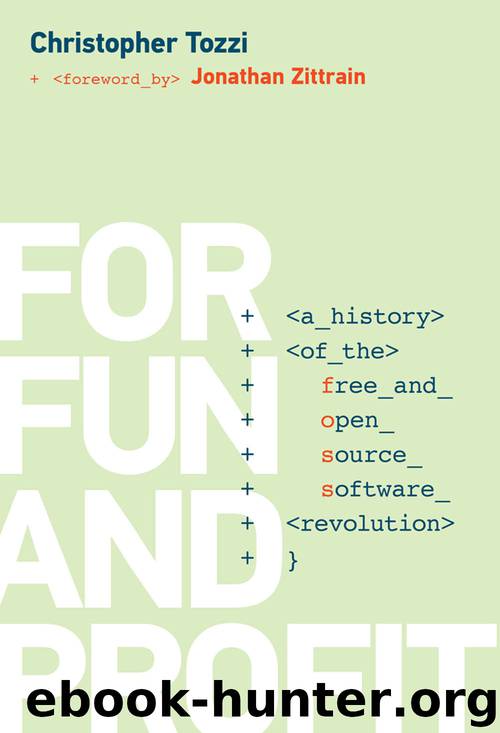For Fun and Profit by Christopher Tozzi

Author:Christopher Tozzi
Language: eng
Format: epub
Publisher: The MIT Press
Published: 2017-07-28T04:00:00+00:00
4 The Moderate FOSS Revolution
One of the main acts in the revolutionary script is the moderate phase. In this part of a revolution, consensus prevails, and competing parties find enough common ground to establish a new, stable order. The moderate phase tends to precede and be less exciting than the dramatic, battle-ridden periods that usually follow. But it is generally during the moderate stage that the most productive and enduring revolutionary changes arise.
For the French revolutionaries, the moderate phase began after Louis XVI bowed to popular demands by accepting constitutional monarchy in the summer of 1789. Over the next few years, the French abolished feudalism, reconfigured church-state relations, and pioneered new modes of representative democracy. After foreign and civil wars began and the king was overthrown and imprisoned in 1792, however, the French Revolution descended into the radical phase known as the Reign of Terror.
The Russian Revolution followed a similar trajectory. A relatively peaceful revolution in March 1917 resulted in a new, provisional government that was dominated by centrist factions. These groups shared power with the more radical Bolsheviks until the latter launched a second revolution in November. The struggle between Red Bolsheviks and their White Russian enemies then enveloped the country in a prolonged civil war, complicated by foreign intervention, which erased hopes for moderate reform.
The free and open source software (FOSS) revolution also had a moderate phase. The early and mid-1990s constituted an eventful yet peaceable period during which different factions within the FOSS community collaborated readily with one another. The unchecked momentum of the Linux kernel and the various programs that GNU developers produced gave rise to operating systems through which FOSS reached the masses for the first time. Meanwhile, new values and methods, like those that grew up around the Apache Group (which in 1999 became the Apache Software Foundation), were integrated into the rapidly expanding FOSS ecosystem. FOSS was sufficiently successful to show that a new world was possible but not yet threatening enough to enter the crosshairs of companies like Microsoft, and it flourished.
This chapter chronicles the moderate phase of the FOSS revolution. It focuses on the advent of GNU/Linux distributions, the proliferation of FOSS productivity applications, and the surging commercial significance that these developments introduced to the FOSS world. It also highlights the beginnings of the fissures that started emerging in this period. Despite a general spirit of consensus, opposing factions began staking competing claims to the FOSS revolutionary legacy by adopting different types of licenses and development strategies. FOSS programmers also began attacking closed source software companies loudly for the first time.
Free New World: GNU/Linux Distributions in the 1990s and Early 2000s
The First GNU/Linux Distributions
The code that Ari Lemke posted on a University of Helsinki file transfer protocol (FTP) server in September 1991 represented the first “distribution” of the Linux kernel. But that was not a complete Linux-based operating system. At the time, Linux included little beyond basic kernel code, and users still required Minix to run the system.
Within less than a year,
Download
This site does not store any files on its server. We only index and link to content provided by other sites. Please contact the content providers to delete copyright contents if any and email us, we'll remove relevant links or contents immediately.
Deep Learning with Python by François Chollet(12843)
Hello! Python by Anthony Briggs(10107)
The Mikado Method by Ola Ellnestam Daniel Brolund(9993)
OCA Java SE 8 Programmer I Certification Guide by Mala Gupta(9970)
Dependency Injection in .NET by Mark Seemann(9507)
Algorithms of the Intelligent Web by Haralambos Marmanis;Dmitry Babenko(8508)
Grails in Action by Glen Smith Peter Ledbrook(7868)
Test-Driven iOS Development with Swift 4 by Dominik Hauser(7838)
The Well-Grounded Java Developer by Benjamin J. Evans Martijn Verburg(7753)
Becoming a Dynamics 365 Finance and Supply Chain Solution Architect by Brent Dawson(7633)
Microservices with Go by Alexander Shuiskov(7390)
Practical Design Patterns for Java Developers by Miroslav Wengner(7310)
Test Automation Engineering Handbook by Manikandan Sambamurthy(7251)
Angular Projects - Third Edition by Aristeidis Bampakos(6670)
Secrets of the JavaScript Ninja by John Resig Bear Bibeault(6624)
The Art of Crafting User Stories by The Art of Crafting User Stories(6174)
NetSuite for Consultants - Second Edition by Peter Ries(6112)
Demystifying Cryptography with OpenSSL 3.0 by Alexei Khlebnikov(5922)
Kotlin in Action by Dmitry Jemerov(5281)
